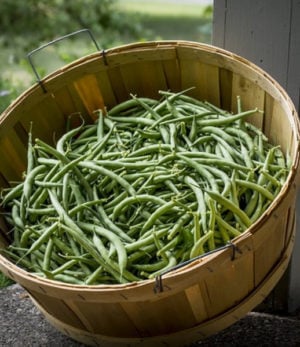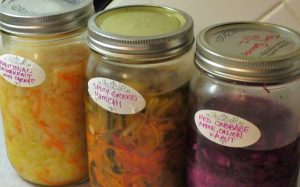"The following is an excerpt from Preserving Food Without Freezing or Canning: Traditional Techniques Using Salt, Oil, Sugar, Alcohol, Vinegar, Drying, Cold Storage, and Lactic Fermentation by the Gardeners & Farmers of Terre Vivante.
Above a certain concentration of salt in food, microorganisms cannot develop and thus the preservation of food is assured."
" Among vegetables, we sometimes salt green beans, herbs, and vegetable mixtures for soup stock.
There are two main disadvantages to preserving food with salt:
The salt must be removed from most foods before consuming them, which usually requires lengthy soaking and repeated rinsing that also eliminate some of the nutrients;
If the salt is not completely removed, we risk consuming more than is considered healthy these days.
However, for preserving foods that we eat in small quantities, or that don’t need much soaking and rinsing, salt has its place."
http://www.chelseagreen.com/blogs/summer-green-beans-4-ways-to-preserve-using-salt/
As you can see from the title of this book, no canning or freezing is required to preserve the green beans. One recipe says that the green beans will last three years.
From the Home Preserving Bible website [above link]: "Dry salting is an old-fashioned method for preserving vegetables, meat, and fish. It was popular in the early twentieth century, especially during the first and second World Wars. Salting was promoted as an alternative to canning in order to conserve glass, metal, and fuel. There are two basic methods for dry salting, one uses low salt concentration and the other uses high salt."
"You want to avoid salt concentrations between 5% and 20%, because in this range you may promote the growth of spoilage bacteria. This will likely produce a stinky, rotten-smelling product that is inedible.
Cabbage is still commonly preserved by dry salting, as sauerkraut or kimchi, both of which use low salt concentration. Sauerkraut is made by layering raw shredded cabbage with salt. Kimchi is made by layering cabbage with salt and other seasonings such as ground dried red chili peppers. You can use the sauerkraut method with other cruciferous vegetables, such as turnips, rutabagas, and kohlrabies. In fact, you can preserve many other vegetables by dry salting. These include cauliflower florets, leafy greens (such as spinach, kale, and chard), shelled peas, and string beans. For best results with this last group, steam blanch the vegetables before layering, rather than leaving the vegetables raw."
"Salting peas
Salting vegetables is an old-fashioned method that you may want to try. Use only young, very fresh peas. Prepare shelled peas or pea pods and then weigh peas before blanching to determine amount of salt to use. For every pound of prepared peas, measure 3.2 ounces (1⁄3 cup) pickling salt. Blanch and drain peas; then pat dry. In a large bowl, toss peas and pickling salt until evenly mixed. Pack 1 pound peas with salt into a sterilized 1-quart glass jar (or 5 pounds into a gallon crock), leaving 1 to 2 inches headspace. Press peas without crushing to extract liquid to cover vegetables. Weight the peas to keep them submerged, and cover the container. Set aside in a cool, dark place. In 24 hours, if the liquid does not cover the food completely, prepare a 20 percent brine using 7.7 ounces (3⁄4 cup) pickling salt per quart of water. Add enough brine to cover the peas generously. Cover and weight again to keep submerged. Cure (pickle) the vegetables 2 to 4 weeks, and then store in a cold cellar or refrigerator up to 6 months. If white scum appears on the surface, remove it. If peas become moldy, soft, or develop a disagreeable odor, they have spoiled and must be discarded."
http://www.homepreservingbible.com/1825-best-food-preservation-methods-for-green-peas-snow-peas-and-snap-peas/
"Brined (salted) zucchini. Choose small, ripe, sound zucchini (free from blemishes). Wash careful and place in a sterilized crock or canning jar and cover with strong (10 percent) brine, leaving at least 1 inch headspace. To make 10 percent brine, stir 3.7 ounces. (6 tablespoons canning/pickling salt or 3/4 cup Diamond Kosher) salt into 1 quart water until dissolved completely. Use a small plate or brine filled bag to weight the vegetables and keep them submerged. Place the salting container on a tray to catch any spill over during curing. Store container at 64°F to 72°F and allow to cure for 2 to 4 weeks. Cover container and store in a cool (40°F to 50°F) location (or a refrigerator). Open the container at least once a week and check for a white scum floating on the surface of the brine. Remove it immediately, if it appears–it isn’t harmful but can create off-flavors if not removed. Keep the vegetables completely submerged in brine at all times during storage. Mold, soft vegetables, or rotten odors indicate spoilage; discard these vegetables without tasting. Under ideal conditions, most salted vegetables can be stored up to 6 months. To use brined vegetables, soak in fresh, cold water for 12 hours, and then prepare in any recipe calling for fresh."
http://www.homepreservingbible.com/1809-food-preservation-methods-for-zucchini-courgette/
"Pickle or ferment vegetables with dry salt. Easy, practical, and inexpensive, you can use dry salt either to pickle or ferment a wide variety of vegetables. High salt concentration prevents fermentation to preserve vegetables in a near-fresh state. Use this method for cauliflower, cooking greens (spinach, kale, chard), shelled peas, and string beans. People familiar with this method consider dry-salted vegetables to be far superior in taste and texture to canned or frozen ones. In contrast, using a low salt concentration causes the vegetables to ferment and make products like sauerkraut or kimchi from cabbage. The sauerkraut method also works on turnips, rutabagas, and kohlrabies, for delicious wintertime sandwich and burger toppings or garnish for charcuterie."
http://www.homepreservingbible.com/608-5-ways-to-preserve-fruits-or-vegetables-other-than-canning-freezing-or-drying/
"Ferment fruits or vegetables into wine or vinegar. When you have a bumper crop of fruits or vegetables, that’s the time to make wine or vinegar. Ferment almost any type of fresh or dried fruit to make a delicious “country” wine. Popular fruit choices include pears, peaches, or plums, and vegetables with a sweet nature, such as beets, carrots, corn, sweet potatoes, tomatoes, or winter squash. Reclaim fruit and vegetable peels before you discard them in the
compost bin and use them to make vinegar. Exploit apple peelings left over after making applesauce, as well as orange peels, pineapple peels, and potato peels. Wine or vinegar making is also a good method to make use of culls, seconds, overripe, or fallen fruit. Just make sure that any of the produce you use is free of any mold, trimmed of any bruises, and thoroughly washed."
In conclusion, after a week or more of searching without success, I decided to just try the High salt method on some cherry tomatoes. Here is the link to the original post that led me on this quest:
Julia Winter's Fermented Lemons
Pros: "However, for preserving foods that we eat in small quantities, or that don’t need much soaking and rinsing, salt has its place."
no canning or freezing is required to preserve the green beans. One recipe says that the green beans will last three years.
Cons: "You want to avoid salt concentrations between 5% and 20%, because in this range you may promote the growth of spoilage bacteria. This will likely produce a stinky, rotten-smelling product that is inedible.

 1
1










 1
1




 1
1




 1
1








 1
1





 1
1

















 1
1




 or using it as most of the acid and salt in peanut sauce. Happy so far! Thank you Anne!
or using it as most of the acid and salt in peanut sauce. Happy so far! Thank you Anne!















 1
1














